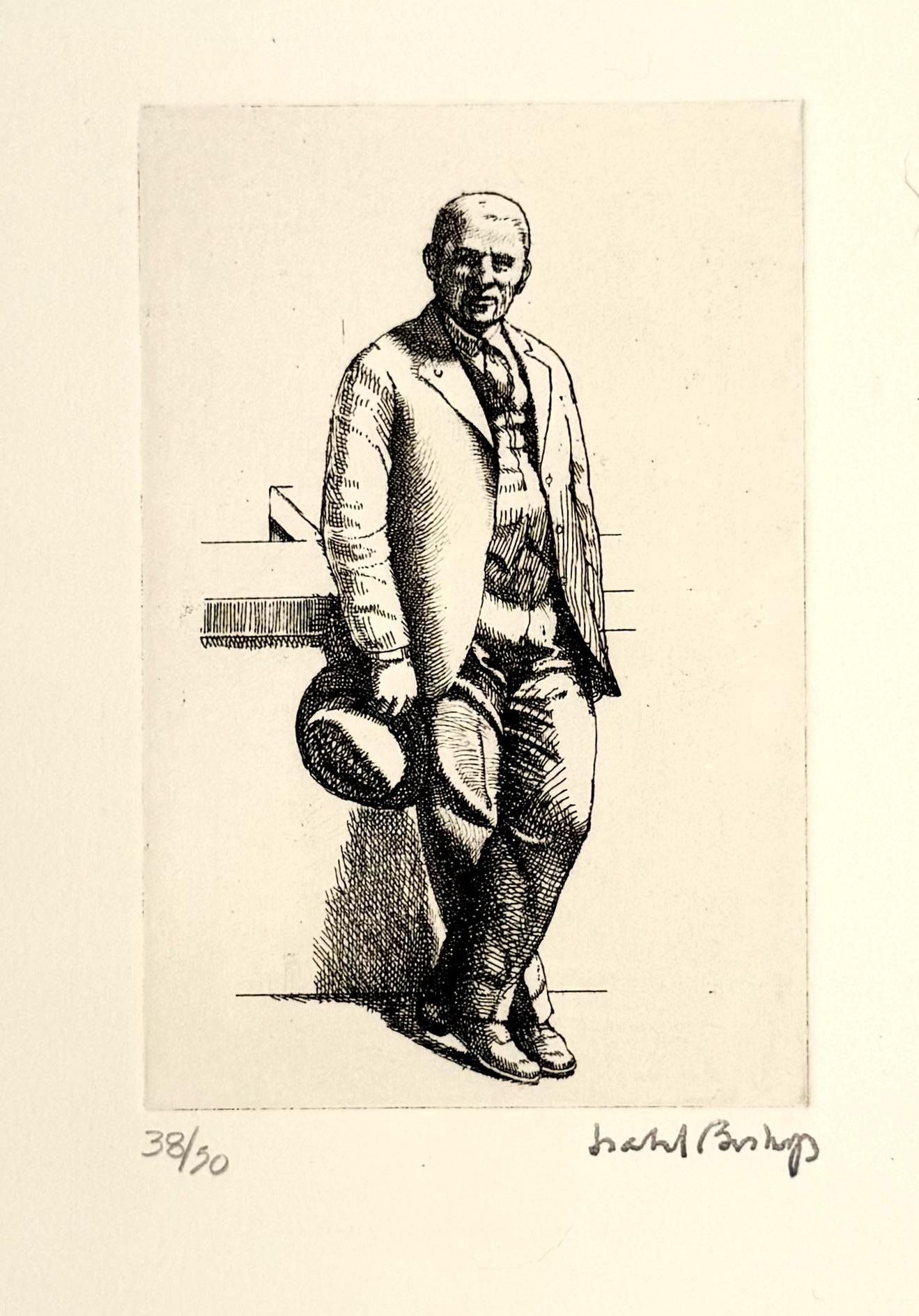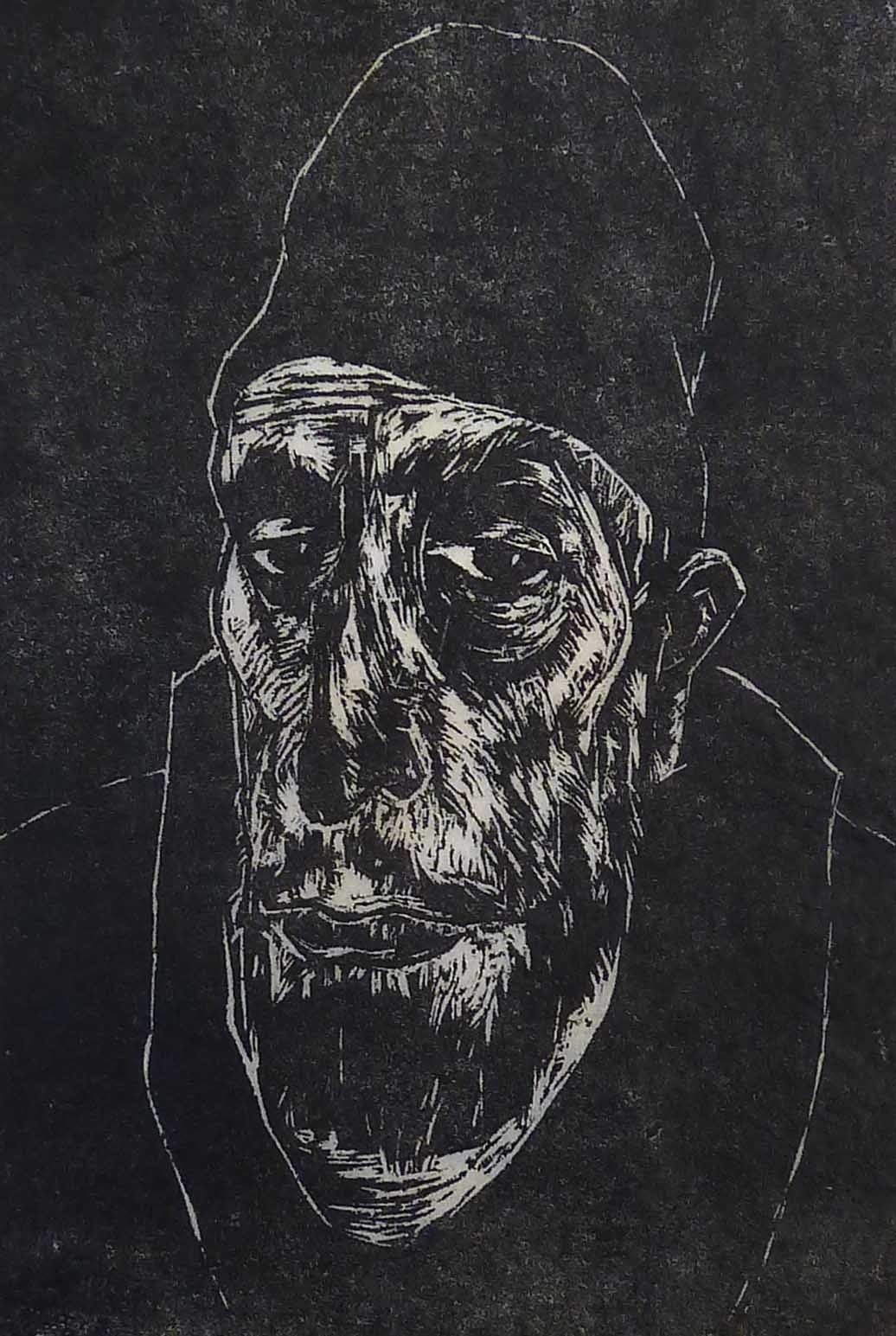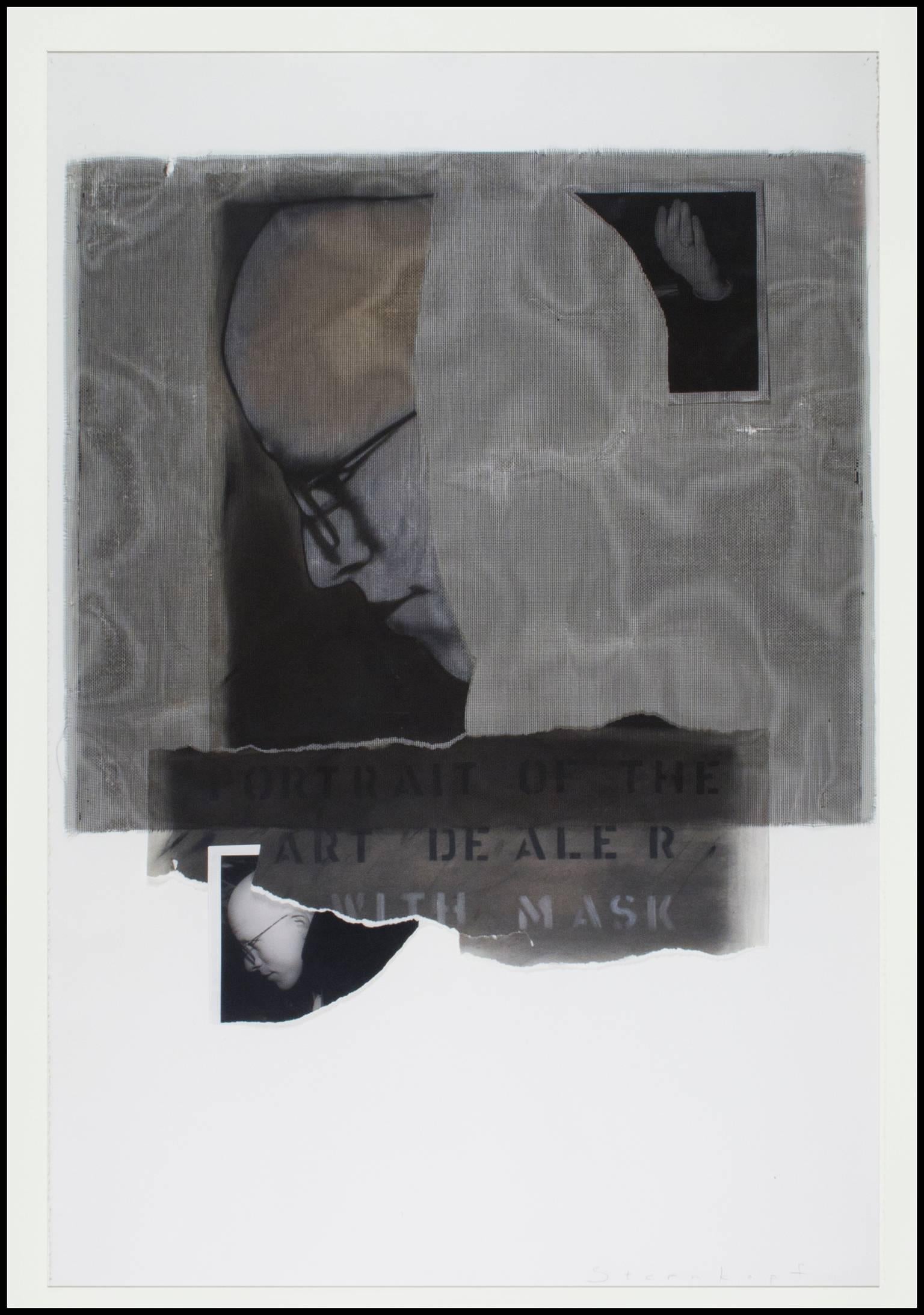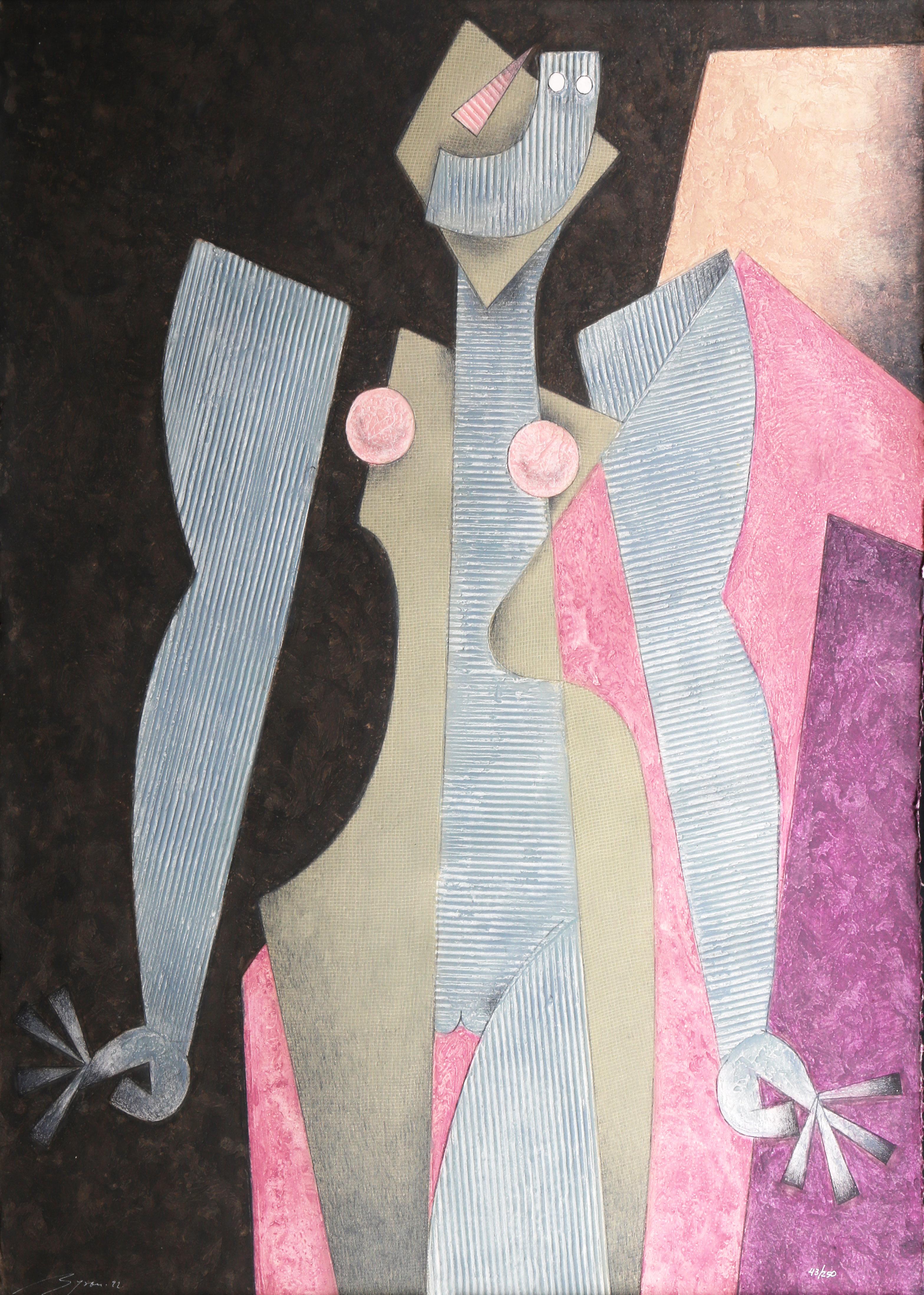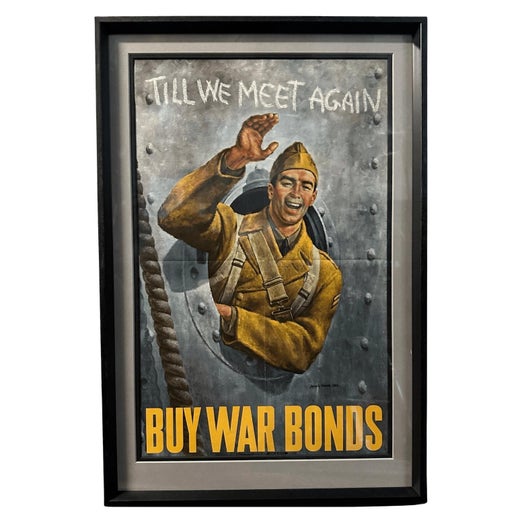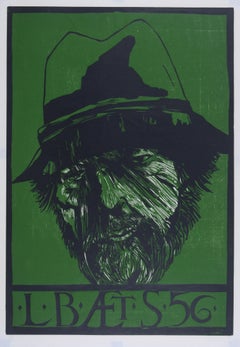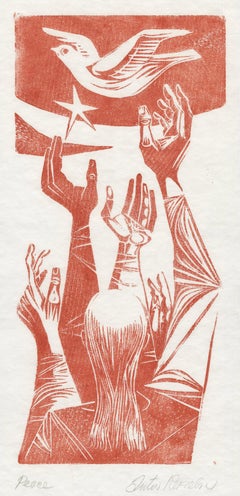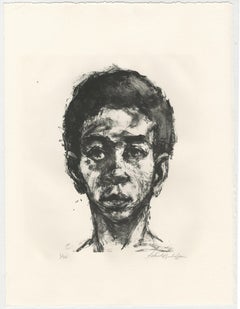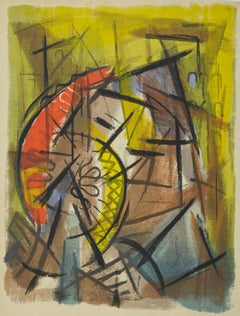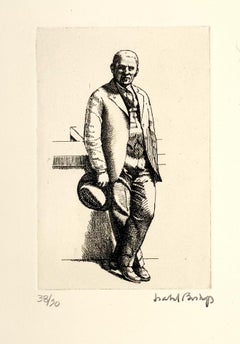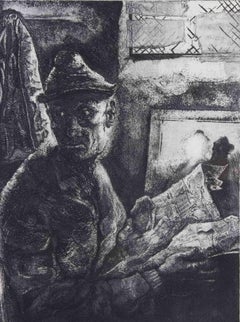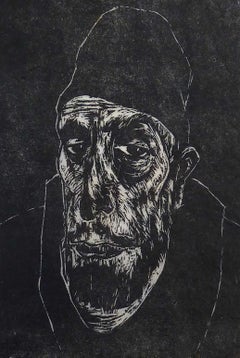Articles similaires à Man avec masque
Vous voulez plus d'images ou de vidéos ?
Demander au vendeur plus d'images ou de vidéos
1 sur 10
Joseph HirschMan avec masque1969
1969
695,21 €
À propos de cet article
Man with Mask
Lithograph, 1969
Signed in pencil by the artist
95/100
Printed by Lucien Detruit, Paris
Published by AAA, New York
Reference: AAA Index No. 60
Condition: Mint
Image size: 14 x 11 7/8 inches
Sheet size: 22 1/8 x 17 15/16 inches
American artist Joseph Hirsch (1910–1981) emerged at the forefront of the Social Realist art movement during the twentieth century, taking inspiration for his work from everyday events and ordinary people. Born and raised in Philadelphia, Hirsch left to pursue art in New York City in the early 1930s. This period, following the end of World War I and at the onset of the Great Depression, saw an increase in economic inequality and racial conflict. Artists such as Hirsch responded to these conditions with politically conscious art depicting poor and working-class people, labor unionists, and the disenfranchised in figurative and realistic images, known today as Social Realism. Hirsch connected art with moral responsibility, arguing, “I believe that someday the fabric of art will be threaded with morality, enabling us to distinguish evil from good. Today this is unthinkable, in the delightful art world where, excepting censorship, anything goes. But anything goes does not accord with the more discriminating ethics of our civilized code which rules out what is socially destructive.”
Banquet was created by Hirsch in 1945 for publication by the Associated American Artists (AAA). Founded by Reeves Lewenthal in 1934, the AAA created original and signed prints in editions of 250, which it distributed for $5 per print or the equivalent of about $85 in 2018. Through department store and mail order sales, as well as traveling exhibitions, the goal of the AAA was to stimulate the American public’s interest in owning fine works of art.
Hirsch’s print comments on the state of the workplace in the 1940s. Following the start of World War II, there was a high demand for workers in war-related industries. However, African Americans were often denied better-paying jobs and were discouraged from joining the military. In 1941, labor and civil rights leader A. Philip Randolph (1889— 1979) threatened a mass march on Washington, D.C., in protest of racial discrimination in industry and the military. In response, President Franklin D. Roosevelt (1882—1945) issued Executive Order 8802 declaring that “there shall be no discrimination in the employment of workers in defense industries or Government because of race, creed, color, or national origin.” Seven years later, Randolph’s advocacy led President Harry S. Truman to ban segregation in the armed forces.
Hirsch, who was white, created this print four years after Roosevelt’s executive order. He portrays two factory workers eating lunch side by side. A white man bites down on a piece of bread, while an African-American man drinks his last sip of coffee. The men are depicted in profile from a perspective that positions us—the viewers—at an equal level, perhaps as another worker on break or a fellow customer at a lunch counter. The print depicts the ideal of racial unity in the workplace and sheds light on these crucial early decades of the Civil Rights Movement.
Hirsch created this print through the process of lithography—a printing process based on the fact that grease and water do not mix. Invented in the late eighteenth century, lithography is a technique which involves drawing on a flat surface, traditionally limestone, with a greasy substance such as a crayon or a liquid called tusche. Once the image is completed and ready to print, the artist applies a chemical mixture on the surface of the stone to secure the image in place. Water is then applied to the surface, adhering to the non-greasy areas of the plate and allowing the artist to roll ink only onto the image. A sheet of paper is placed atop the stone and rolled through a press, allowing the ink to transfer from the stone to create a print. Courtesy Portland Art Museum
:“Joseph Hirsch "scribbled more than the average" when he was a boy and later remembered that his mother often gave him a sketchbook to pass the time. He won a scholarship to art school when he was seventeen and a few years later was one of the youngest painters to receive the Walter Lippincott Prize from the Pennsylvania Academy of the Fine Arts. Hirsch worked as an artist-correspondent during World War II, sketching planes and hospitals throughout the Pacific. His monumental images celebrate ordinary people and situations, reflecting his belief that "any painting that has to do with life is a commemoration." (Hirsch, Recent Paintings and Drawings: May 28-June 13, 1980, Exhibition Catalogue, 1980)
Courtesy SAAM, Washington
"Joseph Hirsch was an American artist, born in Philadelphia, Pennsylvania. He studied at the Pennsylvania Museum and School of Industrial Art before moving to New York City to study with George Luks. Luks introduced the young artist to Social Realism. He served as a pictorial war correspondent for the navy during World War II, making war posters and depicting the troops on the battlefield. Many of his drawings and paintings from this time are in the Museum of Military History.
In an interview, Hirsch once said ''I believe that some day the fabric of art will be threaded with morality, enabling us to distinguish evil from good. Today, this is unthinkable, in the delightful art world where, excepting censorship, anything goes. But anything goes does not accord with the more discriminating ethics of our civilized code which rules out what is socially destructive.''
Courtesy Old Print Shop
- Créateur:Joseph Hirsch (1910 - 1981, Américain)
- Année de création:1969
- Dimensions:Hauteur : 35,56 cm (14 po)Largeur : 30,18 cm (11,88 po)
- Support:
- Mouvement et style:
- Période:
- État:
- Adresse de la galerie:Fairlawn, OH
- Numéro de référence:Vendeur : FA8277_B1stDibs : LU14015724322
Joseph Hirsch
Joseph Hirsch était membre de l'American Academy-Institute of Arts and Letters et un artiste réaliste bien connu qui s'est fait connaître au niveau national en tant que muraliste pour la Federal Works Progress Administration dans les années 1930. À propos de son propre travail, M. Hirsch a écrit : "Je crois qu'un jour, le tissu de l'art sera tissé de moralité, ce qui nous permettra de distinguer le mal du bien. Aujourd'hui, c'est impensable, dans le délicieux monde de l'art où, à l'exception de la censure, tout est permis. Mais le n'importe quoi n'est pas en accord avec l'éthique plus discriminante de notre code civilisé qui exclut ce qui est socialement destructeur. M. Hirsch est représenté au Metropolitan Museum of Art, au Museum of Modern Art et au Whitney à New York ; à la National Gallery, au Corcoran et au Hirshhorn à Washington ; au Boston Museum of Fine Arts, et dans de nombreuses grandes collections aux États-Unis. Joseph Hirsch est né le 25 avril 1910 à Philadelphie, en Pennsylvanie. Hirsch a étudié à la Philadelphia Museum School, avec Henry Hensche à Provincetown (Massachusetts) et avec George Luks à New York. En plus de l'étude formelle, Il a participé à la Works Project Administration dans la division de la peinture de chevalet, avec un travail occasionnel dans la division des peintures murales, où il a peint des peintures murales dans le bâtiment de l'Amalgamated Clothing Workers et dans le tribunal municipal. Pendant la Seconde Guerre mondiale, Joseph Artistics a participé à l'effort de guerre en tant qu'artiste correspondant de guerre, enregistrant les batailles et les événements importants. Il a enseigné à l'Institut d'art de Chicago, à l'American Art School, à l'Université de l'Utah, et a occupé un poste important à l'Art Students League de New York. Il a également reçu de nombreux prix, parmi lesquels une bourse de l'Académie américaine de Rome, le prix Walter Lippincott, le premier prix de l'Exposition universelle de New York (1939), la bourse de la Fondation Guggenheim (1942, 1943) et la bourse Fulbright (1949). En 1954, il a été élu membre associé de la National Academy of Design et est devenu académicien à part entière en 1958 Au début de sa carrière, Hirsch a été initié au mouvement du réalisme social par George Luks, qui faisait partie des "Huit". Ce groupe de peintres, au début du siècle, a choisi de représenter des scènes ordinaires et quotidiennes. C'est de ce mouvement qu'est né le réalisme social des années 1920 et 1930. Le commentaire social constitue l'épine dorsale de la majorité des peintures de Joseph Hirsch. Pendant la Seconde Guerre mondiale, M. Hirsch s'est rendu dans le Pacifique Sud, en Afrique du Nord et en Italie en tant qu'artiste-correspondant pour la marine, et ses peintures et dessins sont conservés au Musée d'histoire militaire. . Dans les grandes collections. L'œuvre de Hirsch est représentée au Metropolitan Museum of Art, au Museum of Modern Art et au Whitney à New York ; à la National Gallery, au Corcoran et au Hirshhorn à Washington ; au Boston Museum of Fine Arts, et dans d'autres collections aux États-Unis. Il a été élu membre de l'Institut national des arts et des lettres en 1967. Hirsch est décédé à New York, NY, le 21 septembre 1981.
À propos du vendeur
5,0
Vendeur reconnu
Ces vendeurs prestigieux sont des leaders du secteur. Ils représentent le summum en matière de qualité et de design.
Vendeur Platine
Vendeurs premium dont la note est supérieure à 4,7 et le délai de réponse de 24 heures maximum
Établi en 1978
Vendeur 1stDibs depuis 2013
815 ventes sur 1stDibs
Temps de réponse habituel : <1 heure
Associations
International Fine Print Dealers Association
- ExpéditionRecherche du devis...Expédition depuis : Akron, OH
- Politique des retours
Certaines parties de cette page ont été traduites automatiquement. 1stDibs ne garantit pas l'exactitude des traductions. L'anglais est la langue par défaut de ce site web.
Garantie d'authenticité
Bien qu'il soit peu probable que la situation se présente, dans le cas où vous rencontreriez un problème d'authenticité d'un article, contactez-nous dans un délai d'un an pour obtenir un remboursement intégral. DétailsGarantie de remboursement
Si votre article n'est pas conforme à la description, est endommagé pendant le transport ou ne vous est pas livré, contactez-nous sous 7 jours pour obtenir un remboursement intégral. DétailsAnnulation sous 24 heures
Vous disposez d'un délai de 24 heures pour annuler votre achat sans motif.Des vendeurs professionnels agréés
Nos vendeurs de renommée mondiale doivent respecter des normes strictes en matière de service et de qualité, afin de préserver l'intégrité de nos fiches produit.Garantie d'alignement des prix
Si vous constatez qu'un autre vendeur a mis en vente le même article à un prix inférieur sur un autre site, nous nous alignerons sur ce prix.Livraison en toute confiance à l'international
Notre réseau de transporteurs de premier ordre propose des options d'expédition spécialisées dans le monde entier, y compris des livraisons personnalisées.Plus d'articles de ce vendeur
Tout afficherSelf-Portrait-L.B. AET 56
Par Leonard Baskin
Self-Portrait-L.B. AET 56
Gravure sur bois en couleur, imprimée en noir et vert, 1978
Signé au crayon en bas à droite (voir photo)
Edition : 150 (97/150)
Condit : Excellent
Image : 3...
Catégorie
années 1970, Modernisme américain, Estampes - Figuratif
Matériaux
Gravure sur bois
La paix
Par Anton Refregier
La paix
Gravure sur bois imprimée à l'encre rouge orange sur papier japonais
Signé et titré au crayon en bas à droite (voir photo)
Titré en bas à gauche (voir photo)
Créé avec un pro...
Catégorie
années 1950, Modernisme américain, Estampes - Figuratif
Matériaux
Gravure sur bois
Fils de l'Amérique II (Sonni)
Par Sedrick Huckaby
Fils de l'Amérique II (Sonni)
Lithographie, 2016
Signé et numéroté au crayon
De : La famille américaine II
Imprimeur : James Reed à Milestone Graphics
Imprimé sur papier Arches
Editi...
Catégorie
années 2010, Contemporain, Estampes - Figuratif
Matériaux
Lithographie
Le ventilateur
Par Leonard Pytlak
Le ventilateur
Sérigraphie en couleurs, années 1950
Signée et numérotée au crayon par l'artiste (voir photos).
Edition : 40 (24/40)
Condit : très bien.
Taille de l'image : 25 1/8 x 1...
Catégorie
années 1950, Modernisme américain, Estampes - Abstrait
Matériaux
Écran
Passion noire
Par Rudy O. Pozzatti
Passion noire
Lithographie sur plaque d'aluminium à partir de deux plaques, 1975
Signé, titré et numéroté au crayon par l'artiste
Edition 50
Publié au Lakeside Studio avec le maître ...
Catégorie
années 1970, Modernisme américain, Estampes - Figuratif
Matériaux
Lithographie
Tête de femme
Par Elie Nadelman
Edition de 50 exemplaires imprimés par Charles White en 1951 pour la succession.
Bibliographie :
Lincoln Kirstein, Elie Nademan (New York : The Eakins Press, 1973),, 20
Elie Nadel...
Catégorie
années 1920, Modernisme américain, Estampes et éditions
Matériaux
Pointe sèche
Suggestions
ard de bœuf
Par Joseph Hirsch
Joseph Hirsch avait une telle empathie pour ses sujets ! Mais il était aussi un lithographe incroyablement doué, capable d'extraire de la pierre des détails extrêmement délicats. Sig...
Catégorie
Milieu du XXe siècle, Modernisme américain, Estampes - Figuratif
Matériaux
Lithographie
Homme tenant un chapeau
Par Isabel Bishop
New York : Sylvan Cole, 1929.
Gravure à l'eau-forte sur papier vélin blanc de Rives avec filigrane à l'infini, 5 15/16 x 3 15/16 pouces (151 x 100 mm) ; feuille 15 7/16 x 11 15/16 p...
Catégorie
années 1920, Réalisme américain, Estampes - Portrait
Matériaux
Pointe sèche, Aquatinte
Man with Newspaper Gravure de Piero Cesaroni - 1973
Par Piero Cesaroni
L'homme au journal est une œuvre d'art réalisée par l'artiste italien Piero Cesaroni (Brescia, 1944) en 1973.
Gravure originale en noir et blanc sur papier.
Signé et daté à la main...
Catégorie
années 1970, Contemporain, Estampes - Figuratif
Matériaux
Eau-forte
Mannequin juif
Par Fedor Loevenstein
FEDOR LOEVENSTEIN LOWENSTEIN 1901-1947
(tchèque / français)
Titre : Homme juif, début des années 1920
Technique : Gravure sur bois originale signée à la main, numérotée et ti...
Catégorie
années 1920, Cubisme, Estampes - Portrait
Matériaux
Papier
« Art Dealer With Mask (Portrait de David Barnett) », supports mixtes signé
Par Carol Sternkopf
"Art Dealer With Mask (Portrait of David Barnett)" est un collage original de Carol Sternkopf. Il représente David Barnett, artiste et galeriste, construit en noir et blanc à partir ...
Catégorie
années 1980, Estampes - Figuratif
Matériaux
Technique mixte
Masque, lithographie en relief de Byron Galvez
Par Byron Gálvez
Tirée à 250 exemplaires, cette estampe de nu cubiste dynamique décompose les détails de la forme féminine en questions d'anatomie de base. Cette pièce est signée et numérotée au cray...
Catégorie
Fin du 20e siècle, Estampes - Abstrait
Matériaux
Lithographie
